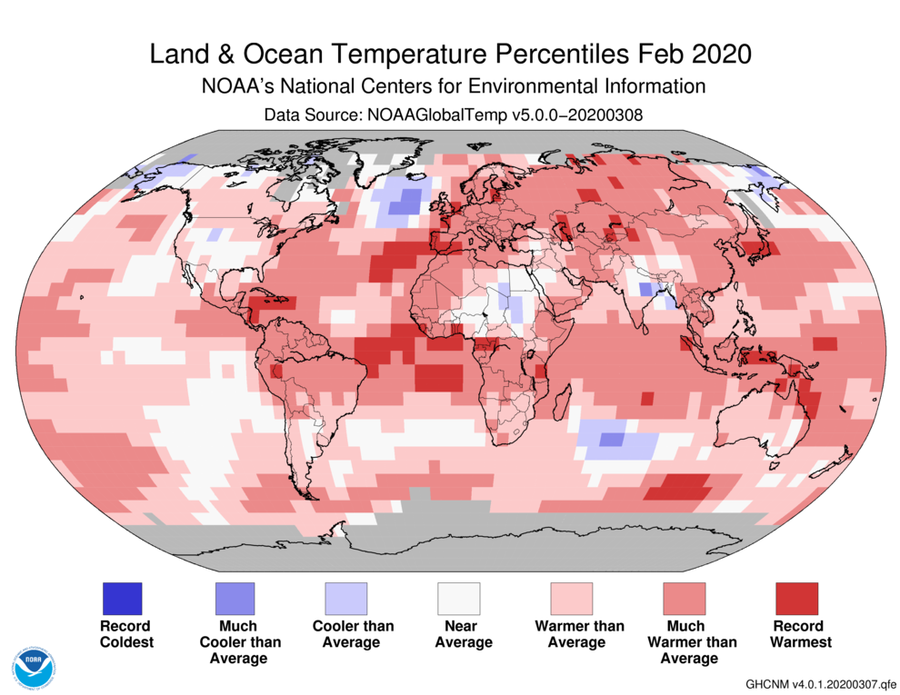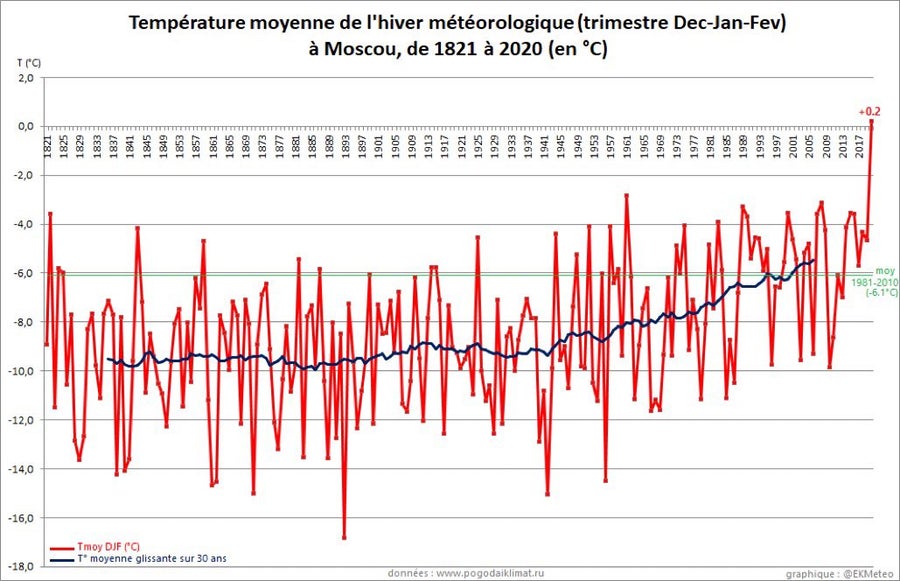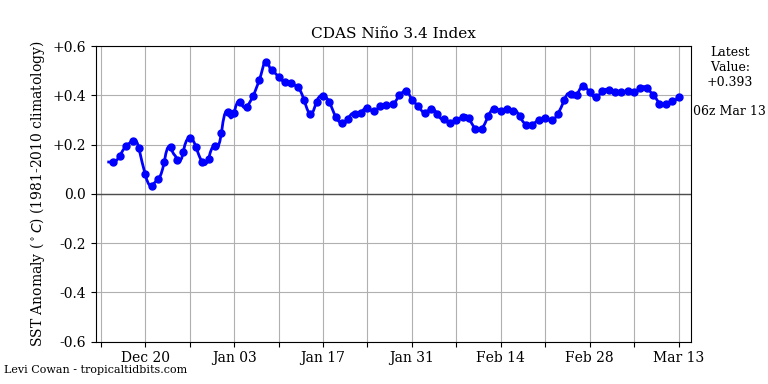This article was published in Scientific American’s former blog network and reflects the views of the author, not necessarily those of Scientific American
February 2020 was the planet's second warmest February since record keeping began in 1880, said NOAA's National Centers for Environmental Information (NCEI) on Thursday. NASA also rated February 2020 as the second warmest February on record, with the only warmer February coming in 2016.
Remarkably, February 2020 had the third highest monthly temperature departure from average for any month in the 1,682-month record, dating back to 1880: 1.17°C (2.11°F) above the 20th century average. Only March 2016 (+1.31°C / +2.36°F) and February 2016 (+1.26°C / +2.27°F) had a higher temperature departure. Both of those warmer months came during a near-record strong El Niño event. Global temperature records are more likely to be set during El Niño events, due to the extra heat the tropical Pacific Ocean gives up to the atmosphere. The fact that the February 2020 warmth came without the boost of an El Niño event--and during the minimum of one of the weakest 11-year solar cycles in the past century--speaks to the dominant role human-caused global warming has in heating our planet.
Global ocean temperatures during February 2020 were the second warmest on record, and global land temperatures were also the second warmest on record. Global satellite-measured temperatures in February 2020 for the lowest 8 km of the atmosphere were the second warmest in the 40-year record, according to the University of Alabama Huntsville (UAH) and RSS.
On supporting science journalism
If you're enjoying this article, consider supporting our award-winning journalism by subscribing. By purchasing a subscription you are helping to ensure the future of impactful stories about the discoveries and ideas shaping our world today.

Figure 1. Departure of temperature from average for February 2020, the second warmest February for the globe since record keeping began in 1880. Unusually warm temperatures engulfed much of Russia and Europe, with a few locations having record warm February temperatures (Spain tied for its warmest February on record). Other record warm temperatures were present across parts of the Indian Ocean, western Pacific Ocean, and Atlantic Ocean, including a number of Caribbean islands. Credit: NOAA National Centers for Environmental Information (NCEI)
Europe and Asia smash their records for all-time warmest winter
December 2019 - February 2020 was record warm for Europe and Asia, surpassing their previous record set in 2016 and 2007, respectively, by a huge margin: over 0.70°C / 1.26°F. Europe and Asia's temperature departures of +3.29°C (+5.92°F) and +3.22°C (+5.80°F) above average, respectively, marked the first time Europe and Asia's winter temperature exceeded 3.0°C (5.4°F) since regional records began in 1910.
The Northern Hemisphere and Southern Hemisphere had their second warmest December–February period on record. Only December 2015 - February 2016 was warmer.
The extraordinary warmth in Europe and Asia was largely due to a strongly positive phase of the Arctic Oscillation (AO). During a positive AO, very strong winds circulate in the jet stream which trap very cold air at the poles, while the mid-latitudes tend to have warmer-than-average temperatures. During February 2020, the daily AO index was very high, setting a new all-time record high value on 21 February 2020 at 6.07.
Remarkable snow droughts in Finland, Poland, Denmark, the Netherlands,and Germany
For the first time in recorded history, Poland had stations that passed the whole winter without any snow accumulation. Both Wroclaw and Poznan had zero snowfall during the December through February. Berlin, Copenhagen, and Amsterdam also had zero snowfall for the winter.
Thanks go to Maximiliano Herrera for this info.
For the first time in recorded history, Helsinki, Finland had zero snowfall recorded during the months of January and February.
Winter sports suffer in Europe
The oldest continuously run ski race in the world, the Tar Skiiing race in Finland, was canceled due to lack of snow this year. The race, set to run in Oulu in central Finland on February 29, has been run since 1889. For the first time in its 47-year history, another major ski event in Finland, the Finlandia, also had to be canceled this winter because of lack of snow.
On February 21, the Finland Ice Marathon ice skating race had to be shortened by half in the middle of the race because the ice conditions changed abruptly: "Suddenly, an ice ridge rose under the Rönö bridge, and the lake ice was covered by a 20 cm thick layer of water". This is the first incidence of such an interruption since the event began in 1984. (Ironically, this event used to be held in the Netherlands, but was moved to Finland when ice conditions became too unpredictable in the Netherlands). Thanks go to Maria Haanpää for this info.
Russia smashes its all-time February heat record by nearly 4°C
On February 28, Kassoumkent (Dagestan Republic) in southwest Russia near the Azerbaijan border hit an astonishing 28.2°C (82.8°F), beating the previous national monthly heat record in Russia of 24.5°C (set 27 February 2016 at Goriatchi Klioutch). The new record was an extraordinary 3.7°C (6.7°F) higher than the old record, a rare feat for a country as big as Russia, where weather records go back more than a century. Thanks go to Jérôme Reynaud for this info.

Figure 2. Average winter temperature (December-January-February) in Moscow, Russia, from 1821 – 2020. The average temperature during the winter of 2019 – 2020 was 0.2°C (32.4°F)—Moscow’s first above-freezing average temperature in recorded history, and a full 3°C (5.4°F) above the previous record set in 1961. Moscow’s winter temperatures were an extraordinary 6.3°C (11.3°F) above the 1981 – 2010 average. Credit: Etienne Kapikian, Meteo France
Moscow crushes its all-time record for warmest winter by 3°C
In Moscow, Russia, where weather records extend back to 1821, the December through February period was by far the warmest winter on record, a full 3°C (5.4°F) above the previous record set in 1961. Moscow’s winter temperatures were an extraordinary 6.3°C (11.3°F) above the 1981 – 2010 average. Thanks go to Etienne Kapikian for this info.
Unprecedented winter warmth in Germany and Denmark
Weather records expert Maximilano Herrera relayed to me two records he found exceptionally noteworthy: the total lack of freezing temperatures for the whole winter in the Danish stations of Roesnaes and Hvide Sande, and the German station of Helgoland. German weather expert Michael Theusner confirmed that the minimum temperature at Heligoland for the whole winter was +1.1 °C on the 1st of January, making this the first winter since records began in 1952 without a freezing temperature. List on the German island of Sylt also did not record a below-freezing temperature during the winter of 2019 - 2020. This had never occurred before, in records dating back to 1937. Also, in Japan, Hiroshima had its first winter without below-freezing temperatures, as did Le Goeree in the Netherlands and Zeebrugge in Belgium.
One billion-dollar weather disaster in February 2020
One billion-dollar weather-related disaster hit the Earth last month, according to the February 2020 Catastrophe Report from insurance broker Aon: Windstorm Ciara in Western & Central Europe, which caused damages of $1.9 billion across 17 nations February 9 – 10, killing 14 people. In addition, a severe weather outbreak on February 3 – 8 in the Central and Eastern U.S. spawned 37 tornadoes and killed 3 people, causing $925 million in damage. This disaster could well exceed the $1 billion damage threshold in future months, once final damage assessments are complete.
Through the end of February, Earth had seen three billion-dollar weather disasters in 2020:
1. Wildfires, Australia, 11/8 – 1/17, $2+ billion, 34 killed
2. Windstorm Ciara, Western & Central Europe, 2/9 – 2/10, $1.9 billion, 14 killed
3. Severe Weather, 1/10 – 1/12, Central and Eastern U.S., $1.2 billion, 12 killed
Neutral El Niño conditions reign
NOAA’s March 12 monthly discussion of the state of the El Niño/Southern Oscillation (ENSO) stated that neutral ENSO conditions existed, with neither an El Niño nor a La Niña event in progress. Over the past month, sea surface temperatures (SSTs) in the benchmark Niño3.4 region of the eastern tropical Pacific, though warmer than average, have been below the 0.5°C above-average threshold need to be considered El Niño conditions.
Forecasters at NOAA and the International Research Institute for Climate and Society (IRI) are calling for a roughly 65% chance of neutral conditions continuing through the Northern Hemisphere spring, and a 55% chance of continuing into the fall of 2020. They put the odds of an El Niño forming by the August-September-October peak of the hurricane season at about 20%, and the odds of a La Niña event at 35%. The ENSO models have grown increasingly in favor of a La Niña event forming by fall; see Bob Henson’s February 26 post at the Weather Underground Category 6 blog for a detailed analysis. Atlantic hurricane seasons tend to be much more active during La Niña conditions than during El Niño conditions, due to weaker upper-level winds creating lower amounts of wind shear.

Figure 3. Departure of sea surface temperatures (SSTs) in the benchmark Niño 3.4 region (in the equatorial Pacific) ending on March 13, 2020. Over the past month, SSTs were about 0.3 - 0.4°C above average, falling short of the 0.5°C above-average threshold need to be considered El Niño conditions. Credit: Levi Cowan tropicaltidbits.com
Arctic sea ice: thirteenth lowest February extent on record
Arctic sea ice extent during February 2020 was the thirteenth lowest in the 41-year satellite record, according to the National Snow and Ice Data Center (NSIDC). The ice extent was higher than seen in recent years thanks to a strongly positive phase of the Arctic Oscillation (AO).
Antarctic sea ice extent in February 2020 was on the low side of average, and reached its annual summer minimum on February 20.
Notable global heat and cold marks for February 2020
Hottest temperature in the Northern Hemisphere: 43.0°C (109.4°F) at Kolda, Senegal and Kayes, Mali, 24 February
Coldest temperature in the Northern Hemisphere: -65.0°C (-84.9°F) at Geo Summit, Greenland, 28 February
Hottest temperature in the Southern Hemisphere: 46.8°C (116.2°F) at Richmond, Australia, 1 February
Coldest temperature in the Southern Hemisphere: -62.9°C (-81.2°F) at Concordia, Antarctica, 29 February
Highest 2020 average temperature to date (1 Jan-29 Feb) worldwide: 33.1°C (91.6°F) at Telfer, Australia
Highest 2020 average temperature to date (1 Jan-29 Feb) in the Northern Hemisphere: 31.0°C (87.8°F) at Choluteca, Honduras
(Courtesy of Maximiliano Herrera.)
Major weather stations that set (not tied) new all-time heat or cold records in February 2020
Among global stations with a period of record of at least 40 years, 21 set new all-time heat records in February, and 0 set all-time cold records:
Young (Australia) max. 44.8°C, 1 February
Oberon (Australia) max. 38.6°C, 1 February
Taralga (Australia) max. 40.2 °C, 1 February
Burrinjuck Dam (Australia) max. 44.3°C, 1 February
Whitianga (New Zealand) max. 33.1°C, 1 February
Te Puke (New Zealand) max. 33.0°C, 1 February
Napier Airport (New Zealand) max. 37.4°C, 2 February
Kaitaia Airport (New Zealand) max. 31.3°C, 2 February
Lome (Togo) max. 37.8°C, 2 February
Chatham Island Airport (New Zealand) max. 26.8°C, 3 February
Whangarei (New Zealand) max. 33.5°C, 4 February
Taro Island (Solomon Islands) max. 34.9°C, 4 February
Base Esperanza (Antarctica) max. 18.4°C, 6 February
Koumac (New Caledonia, France) max. 36.0°C, 7 February
Lagos (Nigeria) max. 37.8°C, 8 February
Base Arturo Prat (Antarctica) max. 13.0°C, 9 February
Puerto Parra (Colombia) max. 40.4°C, 19 February
Jerusalen (Colombia) max. 42.6°C, 19 February
Pastaza (Ecuador) max. 35.2°C, 21 February
Port Harcourt (Nigeria) max. 38.5°C, 24 February
Daloa (Cote d' Ivoire) max. 40.0°C, 29 February
One all-time national/territorial heat record set or tied in 2020
As of March 13, one nation had set an all-time national heat record in 2020:
Colombia: 42.6°C (108.9°F) at Jerusalen, 19 February (tie)
No all-time national cold records have been set thus far in 2020.
(Courtesy of Maximiliano Herrera.)
Twenty-three monthly national/territorial heat record beaten or tied in 2020 as of March 13
As of March 13, 23 national monthly all-time heat records had been beaten or tied in 2020:
January (11): Norway, South Korea, Angola, Congo Brazzaville, Dominica, Mexico, Indonesia, Guinea Bissau, Gambia, Sao Tome and Principe, Cuba
February (10): Spain, Antarctica, Azerbaijan, Costa Rica, The Bahamas, Switzerland, Maldives, Gambia, Russia, Seychelles
March (2): Paraguay, Cabo Verde
No monthly national cold records have been beaten or tied in 2020.
(Courtesy of Maximiliano Herrera.)
Hemispherical and continental temperature records in 2020
Highest minimum temperature ever recorded the Northern Hemisphere in February: 29.1°C (84.4°F) at Bonriki, Kiribati, 17 January.
Highest maximum temperature ever recorded in North America in February: 42.0°C (107.6°F) at Vicente Guerrero, Mexico, 21 January.
Highest temperature ever recorded in continental Antarctica and highest February temperature ever recorded in Antarctica plus the surrounding islands: 18.4°C (65.1°F) at Base Esperanza, 6 February.
Highest minimum temperature ever recorded in February in Antarctica: 7.6°C (45.7°F) at Base Marambio, 9 February.
Highest minimum temperature ever recorded in February in the Northern Hemisphere: 32.0°C (89.6°F) at Yelimane, Mali on 23 February.
(Courtesy of Maximiliano Herrera.)